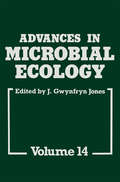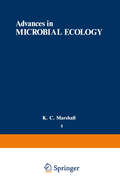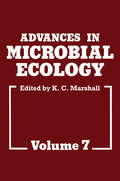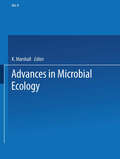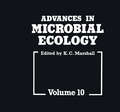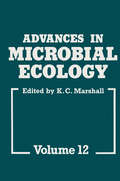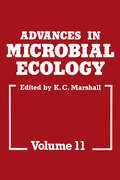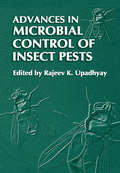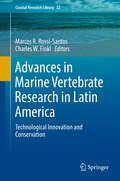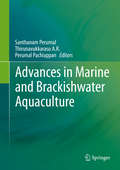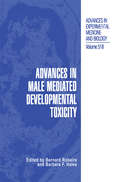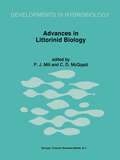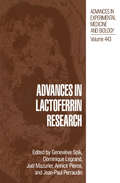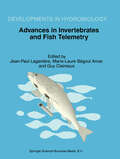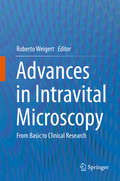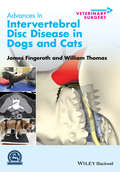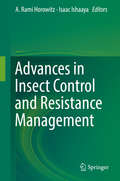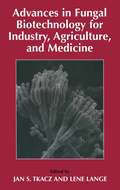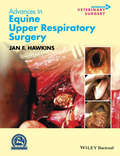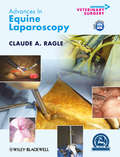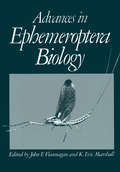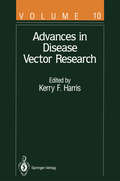- Table View
- List View
Advances in Microbial Ecology (Advances in Microbial Ecology #14)
by John Gwynfryn JonesThere were many who joked when we took over Advances in Microbial Ecology at Volume 13; perhaps they should have reserved their expressions of superstition for Volume 14. As an example of British understatement, I think it would be fair to say that we have had a little bad luck. Never have I known a volume so bedeviled with misfortune, but we have been similarly fortunate in the patience exhibited by our authors, particularly those who were "first in line" with their chapters. It would be inappropriate to burden the reader with the catalogue of accidents and illnesses; suffice it to say that considerable experience has been gained in contingency planning. We feel particularly delighted that the final product is a balanced volume, maintaining the tradition of Advances in Microbial Ecology in providing something for everyone. The chapters range from the strategies of growth to the role of microbes in maintaining sustainable agriculture, the significance of a single biochemical process to the complexities of coping with a wide range of substrates.
Advances in Microbial Ecology: Volume 8 (Advances in Microbial Ecology #8)
by K. MarshallAdvances in Microbial Ecology was established by the International Com mittee on Microbial Ecology (ICOME) as a vehicle for the publication of critical reviews selected to reflect current trends in the ever-expanding field of microbial ecology. Most of the chapters found in Advances in Microbial Ecology have been solicited by the Editorial Board. Individuals are encouraged, however, to submit outlines of unsolicited contributions to any member of the Editorial Board for consideration for inclusion in a subsequent volume of Advances. Contributions are expected to be in depth, even provocative, reviews of topical interest relating to the ecology of microorganisms. With the publication of Volume 8 of Advances we welcome to the panel of contributors Martin Alexander, the founding editor of this series, who discusses the range of natural constraints on nitrogen fixation in agri cultural ecosystems. Ecological aspects of cellulose degradation are dis cussed by L. G. Ljungdahl and K. -E. Eriksson, and of heavy metal responses in microorganisms by T. Duxbury. In his chapter, A. Lee con siders the gastrointestinal tract as an ecological system, and comments on the possibility of manipulating this system. The complex interactions among aerobic and anaerobic sulfur-oxidizing bacteria are discussed in terms of natural habitats and chemostat culture by J. G. Kuenen, L. Rob ertson, and H. van Gemerden. Finally, J. A. Robinson presents the advantages and limitations in the use of nonlinear regression analysis in determining microbial kinetic parameters in ecological situations. K. C. Marshall, Editor R. M. Atlas B. B.
Advances in Microbial Ecology (Advances in Microbial Ecology #7)
by K. MarshallSince the appearance of the first volume of Advances in Microbial Ecology in 1977 under the editorship of Martin Alexander, the series has achieved wide recognition as a source of in-depth, critical, and sometimes provocative reviews on the ecology of microorganisms in natural and man-made ecosystems. Most reviews published in Advances have been prepared by experts at the invitation of the Editorial Board. The Board intends to continue its policy of soliciting reviews, but individuals are encouraged to submit outlines of unsolicited con tributions for consideration of their suitability for publication in Advances. Volume 7 of Advances in Microbial Ecology covers a range of topics related to the ecology of microorganisms in natural and artificial habitats. R. M. Atlas discusses the measurement and significance of diversity in microbial communities. The nature of deserts and the activity of microorganisms in desert soils are considered by J. Skujil)s. D. B. Nedwell examines both the input and the mineralization of organic carbon in anaerobic aquatic sediments. The role of microcosms in the evaluation of interactions between pollutants and microorganisms is the basis of a major review by P. H. Pritchard and A. W. Bourquin.
Advances in Microbial Ecology (Advances in Microbial Ecology #9)
by K. MarshallAdvances in Microbial Ecology was established by the International Com mittee on Microbial Ecology (ICOME) to provide a means for in-depth, critical, and even provocative reviews to emphasize current trends in the rapidly expanding area of microbial ecology. Advances in Microbial Ecol ogy is now recognized as a major source of information and inspiration both for practicing and for prospective microbial ecologists. The majority of reviews published in Advances have been prepared by leaders in par ticular areas following invitations provided by the Editorial Board. Although the Board intends to continue its policy of soliciting reviews, individual microbial ecologists are encouraged to submit outlines of unsolicited contributions to any member of the Editorial Board for con sideration for inclu~ion in Advances. Volume 9 of Advances in Microbial Ecology covers a particularly broad range of topics related to microbial ecology. The potential for applying ribosomal RNA sequence analysis for the definition of natural microbial populations is considered by N. R. Pace, D. A. Stahl, D. J. Lane, and G. J. Olsen. Other reviews on techniques include the applica tion of microelectrode technology to microbial ecosystems by N. P. Revsbech and B. B. J0rgensen and the use of rates of nucleic acid synthe sis to determine bacterial growth rates in natural aquatic habitats by D. J. W. Moriarty. The contribution by T. Fenchel discusses the ecology of heterotrophic microflagellates. J. H. Andrews and R. F. Harris present the concept of r- and K-selection and its relevance to microbial ecology.
Advances in Microbial Ecology (Advances in Microbial Ecology #10)
by K. C. MarshallThe publication of Volume. 10 of Advances in Microbial Ecology repre sents something of a milestone in the history of modern microbial ecol ogy. Advances in Microbial Ecology was established by the International Committee on Microbial Ecology (ICOME) to provide a vehicle for in depth, critical, and even provocative reviews to emphasize current trends in the rapidly expanding field of microbial ecology. Martin Alexander was the Founding Editor of the series and was responsible for editing the first five volumes. The next five volumes were edited by Kevin Marshall. Advances in Microbial Ecology has attained recognition as an authorita tive source of information and inspiration for practicing and prospective microbial ecologists. The Editorial Board usually invites contributions from leading microbial ecologists, but also encourages individuals to sub mit outlines of unsolicited contributions to any member of the Board for consideration for publication in Advances. Contributions to Volume 10 again cover a broad range of topics related to microbial ecology. Interactions between microorganisms are well represented with chapters on bacterium-virulent bacteriophage interactions by R. E. Lenski, on fungal communities in the decay of wood by A. D. M. Rayner and L. Boddy, on recognition in the nematode nematophagous fungus system by B. Nordbring-Hertz, and on phago trophic phytoflagellates by R. W. Sanders and K. G. Porter. Chapters with both an ecological and a biogeochemical flavor include those on atmo spheric CO and H2 by R.
Advances in Microbial Ecology (Advances in Microbial Ecology #12)
by K. C. MarshallAdvances in Microbial Ecology was established by the International Committee on Microbial Ecology (ICOME) to provide a vehicle for in-depth, critical, and even provocative reviews to emphasize recent trends in the important field of microbial ecology. Advances in Microbial Ecology is now recognized as a major source of infor mation and inspiration both for practicing and for prospective microbial ecologists. Most reviews appearing in Advances have been prepared by leaders in particular areas follow ing invitations issued by the Editorial Board. Individuals are encouraged, however, to submit outlines of unsolicited contributions to any member of the Editorial Board for consideration for publication in Advances. With the publication of Volume 12 of Advances in Microbial Ecology there will be a change of Editor and the entire Editorial Board. The current Editor wishes to take this opportunity to thank the present Editorial Board, Ron Atlas, Bo Barker J~rgensen, and Gwyn Jones, as well as past members of the Board, for their assistance and encourage ment over the years. The new Editor of Advances in Microbial Ecology will be Gwyn Jones, with Bernhard Schink, Warwick F. Vincent, and David M. Ward as members of the Editorial Board. The outgoing Board wish the new Board every success in continu ing the traditions established by Martin Alexander, the founding Editor of Advances in Microbial Ecology. The topics featured in Volume 12 of Advances include some related to the meta bolic activities of bacteria; namely, bioremediation of oil spills, by R. M. Atlas and R.
Advances in Microbial Ecology (Advances in Microbial Ecology #11)
by K. C. MarshallThe International Committee on Microbial Ecology (ICOME) sponsors both the Interna tional Symposium on Microbial Ecology, held in various parts of the world at three-year intervals, and the publication of Advances in Microbial Ecology. Advances was estab lished to provide a vehicle for in-depth, critical, and even provocative reviews in microbial ecology and is now recognized as a major source of information for both practicing and prospective microbial ecologists. The Editorial Board of Advances nor mally solicits contributions from established workers in particular areas of microbial ecology, but individuals are encouraged to submit outlines of unsolicited contributions to any member of the Editorial Board for consideration for pUblication in Advances. Chapters in Volume 11 of Advances in Microbial Ecology include those on micro bial transformations of chitin by G. W. Gooday, organic sulfur compounds by D. P. Kelly and N. A. Smith, and phosphorus, including its removal in waste water treatment plants, by D. F. Toerien, A. Gerber, L. H. Lotter, and T. E. Cloete. The importance of diffusion processes in microbial ecology is discussed by A. L. Koch, and 1. I. Prosser reviews the application of mathematical modeling to nitrification processes. Considera tions of particular ecosystems include the Antarctic by D. D. Wynn-Williams and Australian coastal microbial mats by G. W. Skyring and 1. Bauld. Other chapters include the regulation of N2 fixation by H. W.
Advances in Microbial Control of Insect Pests
by Rajeev K. UpadhyayThe insect!1 remain in symbiotic associations with a tremendous number of microorganisms, and some of them could be classified as parasitic/pathogenic. Without question, insect pathogens act as natural mortality agents and represent the third leg of the triad of biological control which is an environmentally sound alternative to chemical control. The virulence and pathogenicity of an insect parasite i. e. disease agent are determined by the microbial genome as a result of the coordinated expression of a concert of genes. These genes may be organized as cassettes and be associated with transmissible DNA. The acquisition of these domains or pathogenicity islands, may be sufficient to develop a transgenic virulent pathogen. The insect pathogens are very specific and this property can be exploited in making insects sick. However, rarely have field applications of highly virulent strains of viruses, fungi, bacteria, protozoa resulted in massive insect population reductions or induced widespread, persistent epizootics as the same is also governed by host susceptibility regulated by genetics, age, sex and physiological state of the host. Insect pathogens causing acute or chronic diseases must be able to persist in the environment, to multiply in the host, and to spread to other susceptible hosts. In this book, I have attempted to bring together all recent studies regarding both fundamental and more applied research aspects related to entomopathogens, bacteria, viruses, fungi and nematodes in order to facilitate their development and commercial exploitation.
Advances in Marine Vertebrate Research in Latin America: Technological Innovation and Conservation (Coastal Research Library #22)
by Marcos R. Rossi-Santos Charles W. FinklThis book gathers the most recent research findings on ecology and conservation of marine vertebrates in Latin America, making use of high technological methods to show readers the diversity of the marine research that has been conducted in these countries over the last decades. The book brings authors from more than 23 institutions of 7 different countries developing the most diverse research aiming at ocean conservation through the ecology of different vertebrate animals, such as whales, dolphins, manatees, turtles, seabirds and fish.This book deals with technological advances and innovation in the ecology and conservation of marine vertebrates in Latin America. This eclectic collection is broad in scope but provides detailed summaries of new methods that are deployed in the study of marine environmental conservation. Key issues revolve around the development and application of educational methodologies in the field of marine vertebrate research, which provide a rational basis for better management of marine environments using modern techniques associated with GIS, satellite tracking, aerial systems, bioacoustics, biogeochemistry, genetics, underwater videography, species photoidentification, molecular biology, trophic ecological methods, ethological methods, and behavioural ecology, among others. Discussion and elucidation of these kinds of techniques are aimed at university-level students and post-graduate researchers. The scope of this volume includes whales, sharks, rays, dolphins, tropical fishes, turtles, manatees as well as aspects of Latin American marine ecosystem conservation. Researchers in this biogeographic region, as well as others involved with marine vertebrate research, will find this work essential reading.
Advances in Marine and Brackishwater Aquaculture
by Santhanam Perumal Thirunavukkarasu A. R. Perumal PachiappanThis book compiles the latest findings in the field of marine and brackishwater aquaculture. It covers significant topics such as techniques of culture of live feeds (microalgae, rotifer, Artemia, marine copepod & polychaetes), while also highlighting vital themes like the culture and applications of free and marine sponge associated microbial probiotics, controlled breeding, seed production and culture of commercially important fin and shell fishes. Moreover, the book focuses on the breeding and culture of marine ornamental fishes, sea cucumber and sea urchin and discusses seaweeds culture, aqua feed formulation and nutrition, water quality management in hatchery and grow-out culture systems, fish disease diagnosis and health management and cryopreservation of fish gametes for sustainable aquaculture practices, all from a multidimensional perspective.The global fish production was 154 million tonnes in 2011 which more or less consisted of capture and culture fisheries (FAO, 2012). Roughly 80% of this is from inland-freshwater aquaculture and the remainder from capture fisheries in the marine and brackishwater sector. However, marine and brackishwater catches have recently begun to diminish due to overexploitation, climate change and pollution. The UNEP report affirmed that if the world remains on its current course of overfishing, by 2050, the ocean fish stock could become extinct or no longer commercially viable to exploit. In these circumstances, aquaculture is considered to be a promising sector to fulfill our future protein requirement. However, brackishwater and marine fish production now face serious challenges due to e.g. lack of quality fish seeds, feeds, poor water quality management and diseases. Fisheries and aquaculture sectors play a vital role as potential sources of nutritional security and food safety around the globe. Fish food is rich in protein, vitamins, phosphorous, calcium, zinc, selenium etc. In addition, fish contains omega-3 fatty acids, which help to prevent cardiovascular diseases. Fish food can also provide several health benefits to consumers. The omega 3 fatty acids found in fish can reduce the levels of LDL cholesterol (the “bad” cholesterol) and increase the HDL levels (the “good” cholesterol). Research conducted in Australia has proved that fish consumption can be used to cure hypertension and obesity. It is also reported that people who ate more fish were less prone to asthma and were able to breathe more easily. Omega 3 fish oil or fish consumption can help to prevent three of the most common forms of cancer: breast cancer, colon and prostate cancer. The omega 3 fatty acids present in fish or fish oil induce faster hair growth and prevent hair loss. Since most varieties of fish are rich in protein, eating fish helps to keep hair healthy. Furthermore, fish or fish oil helps in improving the condition of dry skin, giving it a healthy glow. It is useful in treating various skin problems such as eczema, psoriasis, itching, redness of skin, skin lesions and rashes. It is well known that eating fish improves vision and prevents Alzheimer’s and type-2 diabetes, and can combat arthritis. Further, fish oil or fish is good for pregnant women, as the DHA present in it helps in the development of the baby’s eyes and brain. It helps to avoid premature births, low birth weights and miscarriages. In addition, it is widely known that fish can be a good substitute for pulses in cereal-based diets for the poor. The global fish production was roughly 154 million tonnes in 2011 (FAO, 2012). It is estimated that by 2020 global fish requirements will be over 200 million tonnes; as such, innovative technological improvements are called for in order to improve the production and productivity in fisheries. In this context, this book provides valuable information for academics, scientists, researchers, government officials and farmers on innovative technological advances for sustainable fish production using aquaculture methods.The book identifies the main issues and trends in marine and brackishwater aquacultu
Advances in Male Mediated Developmental Toxicity (Advances in Experimental Medicine and Biology #518)
by Bernard Robaire Barbara F. HalesAdvances in Littorinid Biology: Proceedings of the Fourth International Symposium on Littorinid Biology, held in Roscoff, France, 19–25 September 1993 (Developments in Hydrobiology #111)
by P. J. Mill C. D. McQuaidMembers of the gastropod family Littorinidae are common throughout the world. They form a very abundant component of many intertidal and shallow subtidal ecosystems and, by their grazing, often play a central role in shaping these communities. They also display a wide range of life history strategies and many are polymorphic, making them attractive model organisms for ecologists, evolutionary biologists and physiologists alike. Areas of particular interest include ecological interactions with other animals and with algae, the effects of pollutants and the use of littorinids as sentinel species for monitoring pollution, the effects of parasites on growth and ecology, taxonomy, and the study of genotypic/phenotypic responses to environmental factors. There is still much to be done, and the littorinids are proving to be an ideal group on which to work. Audience: Primarily targeted at the research level. Will also provide useful information for advanced first-degree students conducting research projects.
Advances in Lactoferrin Research (Advances in Experimental Medicine and Biology #443)
by Geneviéve Spik Dominique Legrand Joël Mazurier Jean-Paul ParraudinFollowing the two meetings on Lactoferrin Structure and Function that were held in Honolulu, Hawaii, in 1993 and 1995, the Third International Conference on Lactoferrin Structure and Function was held in Le Touquet, France, and has successfully reinforced and diversified the previously created bridges between biochemists, clinicians, and companies. In fact, scientists, physicians, and people of industry from different domains have brought a wealth of recent information concerning biochemistry and technical advances in the identification of lactoferrin-derived compounds as well as cell biology, molecular biol ogy, pathology, and medical applications of lactoferrin and lactoferrin-derived com pounds. We were so delighted with the rapid growth of knowledge concerning many biologi cal and immunological functions of lactoferrins and the relationships between their struc ture and function, we wanted to share our pleasure with the readers interested in this field. The present book. which represents a review of some of the most exciting contributions, is intended to reflect the status of our knowledge and transmit our hopes for the future devel opment of in vivo applications of natural and recombinant lactoferrins. We would like to express our gratitude to the sponsors who contributed to the or ganization of the meeting in such a pleasant place and allowed the participation of several young researchers. We would also like to thank all the participants who have answered with enthusiasm our invitation and to every one of the Laboratoire de Chimie Biologique for the constant and efficient help.
Advances in Invertebrates and Fish Telemetry: Proceedings of the Second Conference on Fish Telemetry in Europe, held in La Rochelle, France, 5–9 April 1997 (Developments in Hydrobiology #130)
by Jean Paul Lagardere Marie-Laure Begout Anras Guy ClaireauxThis volume provides a selection of the most significant papers presented at the Second Conference on Fish Telemetry in Europe in La Rochelle, France, in April 1997. The conference was attended by 100 scientists from 18 countries. The contributions are grouped under the following headings: Methodology and New Developments, Tagging Procedures, Behavioural and Physiological Ecology, Fish Migration, Stock Management and Conservation. Particular emphasis was put on tag miniaturisation, multiple functions and sampling strategies. Papers concerned the effects of tags on fish for consolidating behavioural or original physiological investigations noticeably more open to the marine environment. Methods were essentially applied to study the relationships between fish and their natural environment. Besides providing up-to-date information on the state of fish telemetry, the book illustrates the increase in spatial and temporal scales and the number of tracked fish which gives a statistical basis for field study in behavioural ecology.
Advances in Intravital Microscopy: From Basic to Clinical Research
by Roberto WeigertThis is the first book entirely dedicated to Intravital Microscopy. It provides the reader with a broad overview of the main applications of Intravital Microscopy in various areas of the biomedical field. The book contains accurate descriptions of the state of the art methodologies used to image various organs at different level of resolution, ranging from whole tissue down to sub-cellular structures. Moreover, it is an extremely valuable guide to scientists that want to adopt this powerful technique and do not have experience with animal models and microscopy.
Advances in Intervertebral Disc Disease in Dogs and Cats (AVS Advances in Veterinary Surgery)
by James M. Fingeroth William B. ThomasAdvances in Intervertebral Disc Disease in Dogs and Cats defines our present knowledge of this common clinical problem, compiling information related to the canine and feline intervertebral disc into a single resource. As a comprehensive, focused work, the book is an authoritative reference for understanding and treating disc disease, providing a sound scientific and clinical basis for decision making. Offering an objective synthesis of the current literature, the book supplies guidance on the approach to a potential disc rupture, surgical and medical strategies, and management of the patient. Offering a complete understanding of intervertebral disc disease, the book describes and discusses the controversies and issues surrounding this topic, acknowledging the gaps in our knowledge. Advances in Intervertebral Disc Disease in Dogs and Cats presents up-to-date, reliable information on this common condition for veterinary surgeons, neurologists, and general practitioners.
Advances in Intervertebral Disc Disease in Dogs and Cats (AVS Advances in Veterinary Surgery)
by James Fingeroth William ThomasAdvances in Intervertebral Disc Disease in Dogs and Cats defines our present knowledge of this common clinical problem, compiling information related to the canine and feline intervertebral disc into a single resource. As a comprehensive, focused work, the book is an authoritative reference for understanding and treating disc disease, providing a sound scientific and clinical basis for decision making. Offering an objective synthesis of the current literature, the book supplies guidance on the approach to a potential disc rupture, surgical and medical strategies, and management of the patient. Offering a complete understanding of intervertebral disc disease, the book describes and discusses the controversies and issues surrounding this topic, acknowledging the gaps in our knowledge. Advances in Intervertebral Disc Disease in Dogs and Cats presents up-to-date, reliable information on this common condition for veterinary surgeons, neurologists, and general practitioners.
Advances in Insect Control and Resistance Management
by A. Rami Horowitz Isaac IshaayaThis book covers advanced concepts and creative ideas with regard to insect biorational control and insecticide resistance management. Some chapters present and summarize general strategies or tactics for managing insect pests such as the principles of IPM in various crop systems and biorational control of insect pests, advances in organic farming, alternative strategies for controlling orchard and field-crop pests. Other chapters cover alternative methods for controlling pests such as disruption of insect reproductive systems and utilization of semiochemicals and diatomaceous earth formulations, and developing bioacoustic methods for mating disruption. Another part is devoted to insecticide resistance: mechanisms and novel approaches for managing insect resistance in agriculture and in public health.
Advances in Fungal Biotechnology for Industry, Agriculture, and Medicine
by Jan S. Tkacz Lene LangeIn the past half century, filamentous fungi have grown in commercial importance not only in the food industry but also as sources of pharmaceutical agents for the treatment of infectious and metabolic diseases and of specialty proteins and enzymes used to process foods, fortify detergents, and perform biotransformations. The commercial impact of molds is also measured on a negative scale since some of these organisms are significant as pathogens of crop plants, agents of food spoilage, and sources of toxic and carcinogenic compounds. Recent advances in the molecular genetics of filamentous fungi are finding increased application in the pharmaceutical, agricultural, and enzyme industries, and this trend promises to continue as the genomics of fungi is explored and new techniques to speed genetic manipulation become available. This volume focuses on the filamentous fungi and highlights the advances of the past decade, both in methodology and in the understanding of genomic organization and regulation of gene and pathway expression.
Advances in Equine Upper Respiratory Surgery (AVS Advances in Veterinary Surgery)
by Jan HawkinsAdvances in Equine Upper Respiratory Surgery is a comprehensive, up-to-date reference on surgical techniques in the upper respiratory tract in the horse, presenting theory and background as well as detailed procedures information. Part of the Advances in Veterinary Surgery series copublished with the ACVS Foundation, the book covers the most common upper respiratory diseases, with in-depth information on laryngeal hemiplegia and dorsal displacement of the soft palate. Providing a complete resource, the book reflects the current state of the art, offering a significant update on disorders of the nasal septum, nasal passage, paranasal sinuses, hard and soft palate, epiglottis, arytenoids, guttural pouch, and trachea in the horse. The book includes 200 images illustrating key points of each surgical procedure. Potential complications and expectation management are discussed alongside the technique information. Advances in Equine Upper Respiratory Surgery is a useful reference for those in clinical practice and surgical residents.
Advances in Equine Upper Respiratory Surgery (AVS Advances in Veterinary Surgery)
by Jan HawkinsAdvances in Equine Upper Respiratory Surgery is a comprehensive, up-to-date reference on surgical techniques in the upper respiratory tract in the horse, presenting theory and background as well as detailed procedures information. Part of the Advances in Veterinary Surgery series copublished with the ACVS Foundation, the book covers the most common upper respiratory diseases, with in-depth information on laryngeal hemiplegia and dorsal displacement of the soft palate. Providing a complete resource, the book reflects the current state of the art, offering a significant update on disorders of the nasal septum, nasal passage, paranasal sinuses, hard and soft palate, epiglottis, arytenoids, guttural pouch, and trachea in the horse. The book includes 200 images illustrating key points of each surgical procedure. Potential complications and expectation management are discussed alongside the technique information. Advances in Equine Upper Respiratory Surgery is a useful reference for those in clinical practice and surgical residents.
Advances in Equine Laparoscopy (AVS Advances in Veterinary Surgery #3)
by Claude RaglePart of the Advances in Veterinary Surgery series copublished with the ACVS Foundation and Wiley-Blackwell, Advances in Equine Laparoscopy presents a state-of-the-art reference on laparoscopic skills and procedures in the horse. Chapters are written by the leading experts in the field, and each section includes a practical review of the published literature. Encompassing instrumentation, basic principles, and specific techniques, Advances in Equine Laparoscopy offers an up-to-date, reliable resource for comprehensive information about equine laparoscopy. This current, well-referenced text begins with a section on the fundamentals of laparoscopy, then moves into sections on the clinical application of laparoscopic techniques in the standing or recumbent horse. A companion website offers eight video clips demonstrating selected procedures at www.wiley.com/go/ragle. Advances in Equine Laparoscopy is an invaluable guide for equine surgical specialists and equine clinicians interested in laparoscopic techniques.
Advances in Equine Laparoscopy (AVS Advances in Veterinary Surgery)
by Claude A. RaglePart of the Advances in Veterinary Surgery series copublished with the ACVS Foundation and Wiley-Blackwell, Advances in Equine Laparoscopy presents a state-of-the-art reference on laparoscopic skills and procedures in the horse. Chapters are written by the leading experts in the field, and each section includes a practical review of the published literature. Encompassing instrumentation, basic principles, and specific techniques, Advances in Equine Laparoscopy offers an up-to-date, reliable resource for comprehensive information about equine laparoscopy. This current, well-referenced text begins with a section on the fundamentals of laparoscopy, then moves into sections on the clinical application of laparoscopic techniques in the standing or recumbent horse. A companion website offers eight video clips demonstrating selected procedures at www.wiley.com/go/ragle. Advances in Equine Laparoscopy is an invaluable guide for equine surgical specialists and equine clinicians interested in laparoscopic techniques.
Advances in Disease Vector Research (Advances in Disease Vector Research #10)
by El Desouky Ammar Y. Antignus T. R. Burkot E. P. Camargo Y. Chinzei S. Cohen D. Gonsalves P. M. Graves H. H. Hagedorn R. Hull E. I. Korenberg Yu. V. Kovalevskii G.W. Otim-Nape M. K. Shaw A. J. Shelley W. J. Tabachnick DeMar Taylor J. M. Thresh F. G. Wallace S. D. Yeh A. S. YoungVolume 10 of Advances in Disease Vector Research consists of seven chapters on vectors that affect human or animal health and six chapters on plant pathogens and their vectors. In Chapter 1, Yasuo Chinzei and DeMar Taylor discuss hormonal regulation of vitellogenesis in ticks. Many blood sucking insects and ticks transmit pathogens by engorgement, which induces vitellogenesis and oviposition in adult animals. To investigate the pathogen transmission mechanism in vector animals, information on the host physiological and endocrinological conditions after engorgement is useful and important because pathogen development or proliferation occurs in the vector hosts at the same time as the host reproduction. Chinzei and Taylor have shown that in ticks, juvenile hormone (JH) is not involved in the endocrinological processes inducing vitellogenin biosynthesis. Synganglion (tick brain) factor(s) (vitellogenesis inducing factor, VIF) is more important to initiate vitellogenesis after engorgement, and ecdysteroids are also related to induction of vitellogenin synthesis. In their chapter, based mainly on their own experimental data, the authors discuss the characterization of main yolk protein, vitellogenin (Vg) , biosynthesis and processing in the fat body, and hormonal regulation of Vg synthesis in tick systems, including ixodid and argasid ticks.
